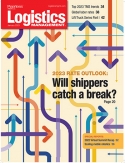Supply Chain and Logistics Technology: Four trends shaping mobility
The market’s top analysts discuss the trends that are pushing mobility deeper into every-day use and explain just how far we are from realizing real-time supply chain management—complete with logistics visibility that was once only the stuff of dreams.

Technology in the News
Catching up with MHI’s Daniel McKinnon Fulfillment Facility Improved Efficiencies by 4x Driving the Risk Out of Line Haul Fleet Management with AIoT Technologies McGuigan to step down as Uber Freight President and COO Scaling mobile robotic fleets for success 更多的技术NewsTechnology Resource
Fulfillment Facility Improved Efficiencies by 4x Download this case study to explore how Winit relied on Hai Robotics’ intelligent case picking robotic system as the core technology to advance their facility, alleviate labor woes, and create operational resilience that helped propel the company’s success over the last 2 years.
Download this case study to explore how Winit relied on Hai Robotics’ intelligent case picking robotic system as the core technology to advance their facility, alleviate labor woes, and create operational resilience that helped propel the company’s success over the last 2 years.All Resources
In some cases, traditional logistics and supply chain operations are slowly but surely giving way to more streamlined, mobile processes that rely heavily on wireless devices and applications to operate at peak efficiency levels around the clock and around the world.
But, many logistics organizations are still saddled with wires, siloed systems, and business partners who don’t communicate with one another. These grim realities are holding many logistics managers back from being able to fully realize the benefits of a truly mobile supply chain—that ultimate, “mobile-centric” Nirvana where shipment visibility becomes second nature.
Over the next few pages we’ll take a look at the top four mobiletrends shaping the supply chainand talk to top analysts about just how far away we are from realizing real-time supply chain management, complete withlogistics visibilitythat was once only the stuff of dreams.
1. Cellular technology is advancing rapidly.If there’s atechnologythat’s helping to get us toreal-time visibilityin a mobile supply chain, it’s mobile devices and the software that makes them tick. The capabilities of both have progressed significantly over the last decade, with even the most basic cellular phones now including GPS functionality, text messaging capabilities, and application functionality.
According to Clint Reiser, research analyst with ARC Advisory Group, several technology-agnostic mobile application platforms have been developed to help suppliers extend their enterprise, supply chain, and commercial applications to mobile devices. These applications run on handheld cellular devices and offer features such as information capture and retrieval, dispatching, driver and route progress tracking, and location and event reporting.
“The performance of the cellular mobility market has progressed much more rapidly than the traditional fleet telematics market—technology that remotely monitors the location, status, health, and activity of vehicles and allows for ongoing two-way communications with drivers,” Reiser says. “Cell phone network coverage has become more extensive and the capabilities of mobile devices and mobile software ecosystems have progressed significantly.”
As cellular technology progresses it’s also slowly displacing older, legacy methods of moving and tracking freight outside of the four walls of the warehouse and distribution center. Those cellular advancements have even outpaced customer requirements, making traditional telematics systems obsolete in many cases.
Cellular technology has partially displaced traditional fleet telematics solutions (which generally include in-cab displays, on-board computers, and satellite communications), adds Reiser, who points to improved handheld devices, more robust application software, and cellular network proliferation as the driving forces behind cellular’s prowess. “Future advancements in modern mobility,” he says, “threaten to displace additional segments of this well-established telematics market.”
2. Device costs have decreased significantly.Ten years ago, it would have been cost prohibitive for the average shipper to outfit its managers, employees, and drivers with handheld phones. Cab-mounted, onboard computers were even further out of reach, often fetching $5,000 or more per unit.
Today, the proposition is much more affordable. The fact that device costs have come down across the board have placed supply chain mobility on the radar screen of more shippers, says Dwight Klappich, research vice president for Gartner.
He points to the Xata Turnpike fleet optimization device as a good example of how onboard computer capabilities can be achieved with just $30-$50 a month versus $5,000 per unit.
The size of a pack of playing cards, the device is powered by a cable connector and uses Bluetooth to communicate with handheld devices. “In the past, the PepsiCos and Coca-Colas of the world were the only companies that could justify the cost of such solutions,” says Klappich. “The guy with five trucks was left out of the loop. Thanks to reduced device price points that’s no longer the case.”
3. Shippers are using mobile to gain un-precedented visibility.There’s nothing quite like a little peer pressure to get shippers to pay attention to advancements in mobile technology. When it comes to the supply chain, visibility gains tend to be the key drivers: when one company achieves them, everyone else wants them too.
“Right now we’re seeing unprecedented visibility across the supply chain made possible by mobile technology,” says Drew Nathanson, director of research operations for VDC Research. Extending from the point of manufacture all the way through to the point of sale, that level of visibility certainly puts the control in the hands of the shipper.
“当公司收到可操作的情报precise product location in the supply chain,” says Nathanson, “they can leverage that information internally and use it to gain operational efficiencies, streamline their operations, and reduce costs.”
4. The consumer is leading the mobile charge.Most of the mobile advancements taking place in the supply chain right now can be traced back to today’s demanding, hyper-informed consumer.
“Customers want to know about everything: product design; delivery times; how to return the product if they don’t like it,” says Tom Wrobleski, vice president for Capgemini Consulting’s supply chain practice. “All of that has to be handled in the background at both the manufacturing and retail levels.”
To make that happen, Wrobleski says an increasing number of companies are turning to mobile devices, solutions, and applications. Visibility over customer orders is a top concern that most supply chain executives are trying to tackle right now, says Wrobleski, who sees cellular devices, mobile applications, GPS locators (for reaching out to the consumer at the point of sale), and the cloud as a few of the most important tools shippers will need to achieve data synchronization and sharing.
“Companies will have to focus on flexing up and handling the proliferation of data and an increasingly demanding consumer,” says Wrobleski. “Mobile will play a key role in helping them achieve those goals in their supply chain operations.”

About the Author
 Bridget McCrea, EditorBridget McCrea is a Contributing Editor for Logistics Management based in Clearwater, Fla. She has covered the transportation and supply chain space since 1996 and has covered all aspects of the industry for Logistics Management and Supply Chain Management Review. She can be reached at[email protected], or on Twitter@BridgetMcCrea
Bridget McCrea, EditorBridget McCrea is a Contributing Editor for Logistics Management based in Clearwater, Fla. She has covered the transportation and supply chain space since 1996 and has covered all aspects of the industry for Logistics Management and Supply Chain Management Review. She can be reached at[email protected], or on Twitter@BridgetMcCrea

Subscribe to Logistics Management Magazine!
Subscribe today. It's FREE!Get timely insider information that you can use to better manage your entire logistics operation.
Start your FREE subscription today!
 Single-Carrier vs. Multi-Carrier Shipping Stategies
Download the white paper to learn about the benefits of multi-carrier shipping with EasyPost.
Download Today!
Single-Carrier vs. Multi-Carrier Shipping Stategies
Download the white paper to learn about the benefits of multi-carrier shipping with EasyPost.
Download Today!
 我们的货运年会万博ag客户端appustry analysts reveals some common themes, largely around the notion that rates are not likely to increase much—if at all—in some modes and will continue declining in others. Does this mean things are stabilizing?
我们的货运年会万博ag客户端appustry analysts reveals some common themes, largely around the notion that rates are not likely to increase much—if at all—in some modes and will continue declining in others. Does this mean things are stabilizing?LM Viewpoint on the 2023 Rate Outlook: Will shippers catch a break? Global Labor Rates: China is no longer a low-cost country View More From this Issue
 2023 Rate Outlook Webcast: Will shippers catch a break?
In this annual webcast, group editorial director Michael Levans hosts our panel of logistics and freight transportation analysts who share their insights on rate patterns in all the major transport modes in an effort to help shippers prepare their freight transportation budget for the coming year.
Register Today!
2023 Rate Outlook Webcast: Will shippers catch a break?
In this annual webcast, group editorial director Michael Levans hosts our panel of logistics and freight transportation analysts who share their insights on rate patterns in all the major transport modes in an effort to help shippers prepare their freight transportation budget for the coming year.
Register Today!








